Solar Inverters and Energy Storage: The Rise of Solar Battery Systems
The energy landscape is undergoing a profound transformation as the world accelerates its shift towards sustainable and renewable sources. Among the prominent technologies leading this charge are solar inverters and energy storage systems. While solar inverters have long been instrumental in converting solar energy into electricity, the integration of energy storage systems has become a game-changer, allowing for the efficient utilization and management of solar power. This article delves into the burgeoning realm of solar battery systems, exploring their impact, benefits, and the pivotal role they play in shaping a sustainable energy future.
What is a Solar Battery?
Let’s begin with a straightforward explanation of what a solar battery is. To store the extra electricity your solar panels create, you may add a solar battery to your solar power setup. Then, on cloudy days, at night, and during blackouts, you may use that stored energy to power your home when your solar panels aren’t producing enough electricity.
Utilizing as much of the solar energy you generate as possible is the goal of a solar battery. Any extra electricity generated by your solar panels is fed into the grid if you don’t have battery storage. This means that you’re producing power and giving it to others without making the most of the electricity your panels provide.
Integrating Energy Storage
One of the recent breakthroughs in the field of solar technology has been the integration of energy storage systems, allowing for the capture and utilization of surplus solar energy. Energy storage systems, particularly solar batteries, store excess energy generated during peak sunlight hours, enabling consumers to use it during periods of low solar production or even at night. This shift has revolutionized the solar industry, addressing the intermittent nature of solar power and making it a more reliable and accessible energy source round the clock.
Advantages of Solar Battery Systems
The rise of solar battery systems has brought forth numerous advantages that have transformed the dynamics of renewable energy usage. Firstly, these systems offer greater energy independence, reducing reliance on the grid and enabling consumers to manage their energy usage more efficiently. Additionally, they contribute to grid stability by providing a reliable source of stored energy, thereby mitigating the impact of fluctuations in solar power generation. Moreover, solar battery systems contribute to the overall resilience of the energy infrastructure, making it more adaptable and less susceptible to disruptions.
What happens when you pair solar inverters with batteries?
Batteries are no longer an optional extra; rather, they are a need as we grow more knowledgeable and proficient in solar energy management. The ability to generate power independently or remain dependent on the grid and the associated high costs is largely dependent on batteries. Because they can convert energy from batteries and solar panels, hybrid inverters are the greatest option in this regard. By the way, without a battery, no solar power system is complete.
Challenges and Future Outlook
Despite the rapid advancements and benefits, the widespread adoption of solar battery systems does encounter certain challenges. The initial installation costs, albeit decreasing with technological advancements, remain a barrier for many consumers. Additionally, the need for effective regulations and policies that support the integration of energy storage systems into the existing energy infrastructure is crucial for ensuring a smooth transition to a more sustainable energy ecosystem.
Looking ahead, the future of solar inverters and energy storage appears promising. Continued research and development efforts are poised to drive down costs, improve efficiency, and enhance the overall performance of solar battery systems. Furthermore, increased collaborations between technology providers, policymakers, and energy stakeholders can foster a conducive environment for the proliferation of these technologies, accelerating the global transition towards a cleaner and more sustainable energy future.
Conclusion
The convergence of solar inverters and energy storage systems marks a significant milestone in the pursuit of a greener and more sustainable energy landscape. By unlocking the full potential of solar energy and addressing the challenges associated with its intermittency, solar battery systems are poised to play a pivotal role in reshaping the dynamics of global energy consumption. With the continued advancements and growing support for renewable energy initiatives, the rise of solar battery systems signifies a transformative shift towards a more resilient, efficient, and environmentally conscious energy paradigm.

